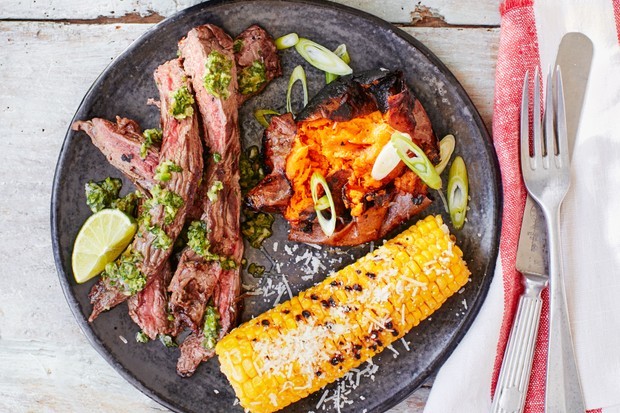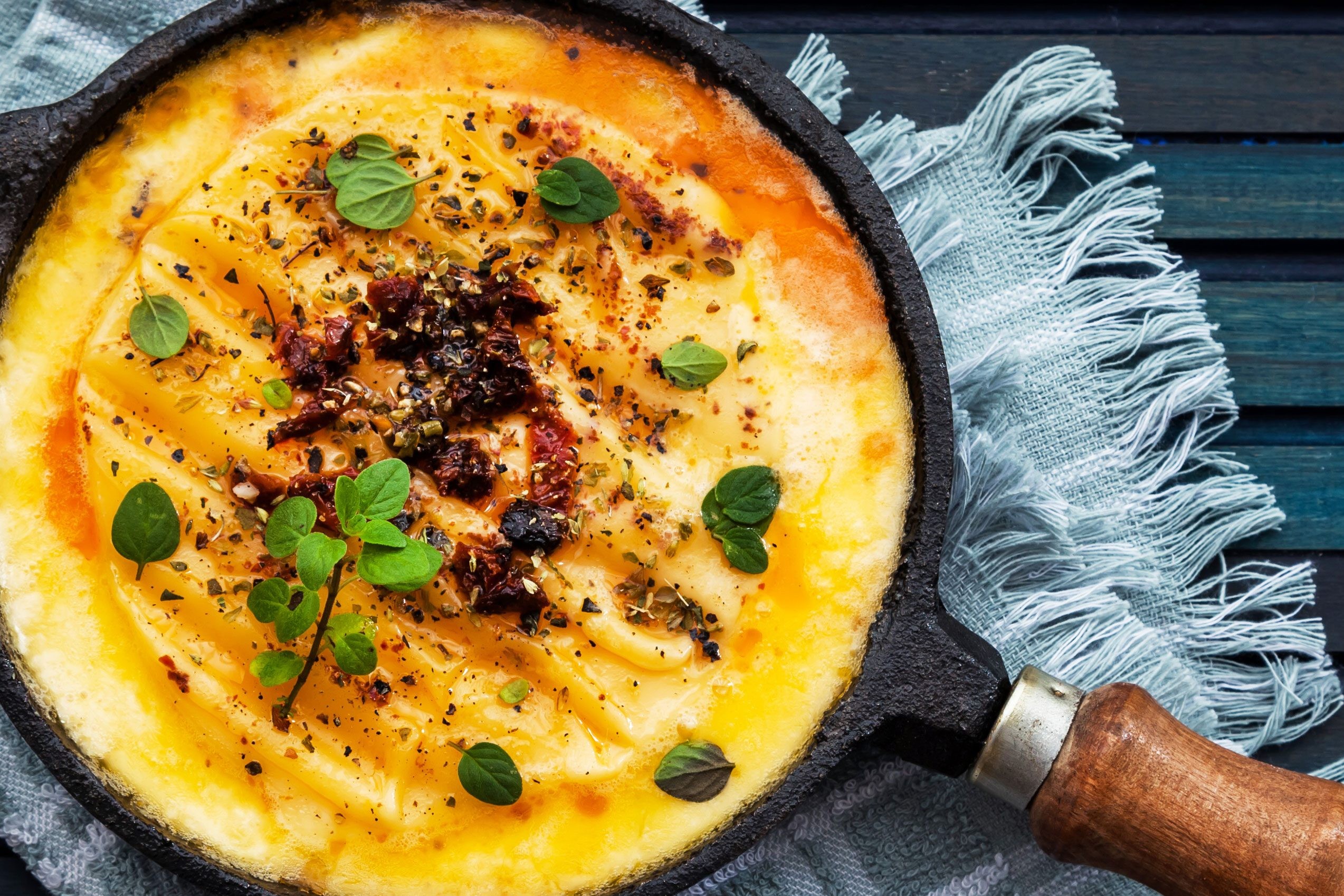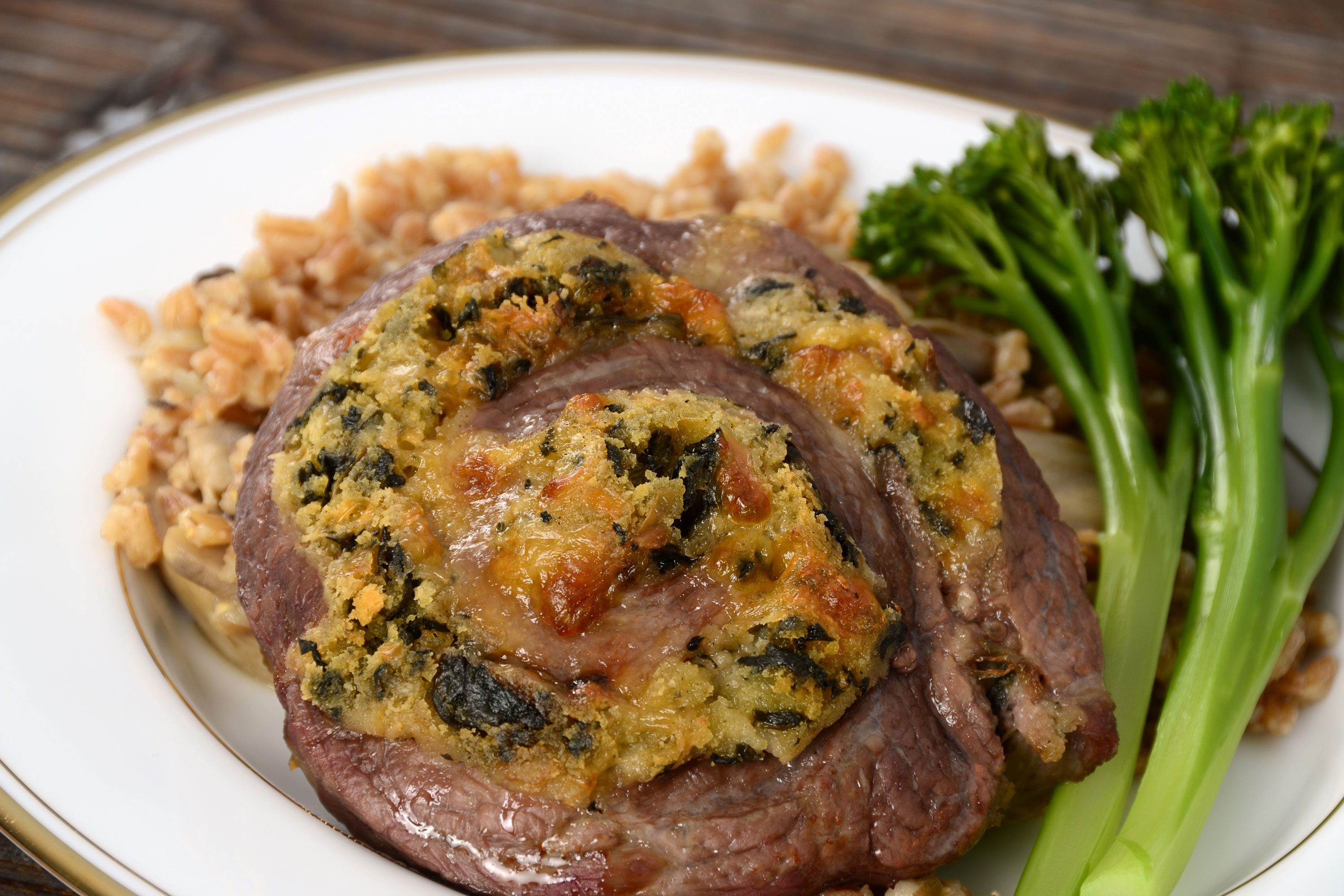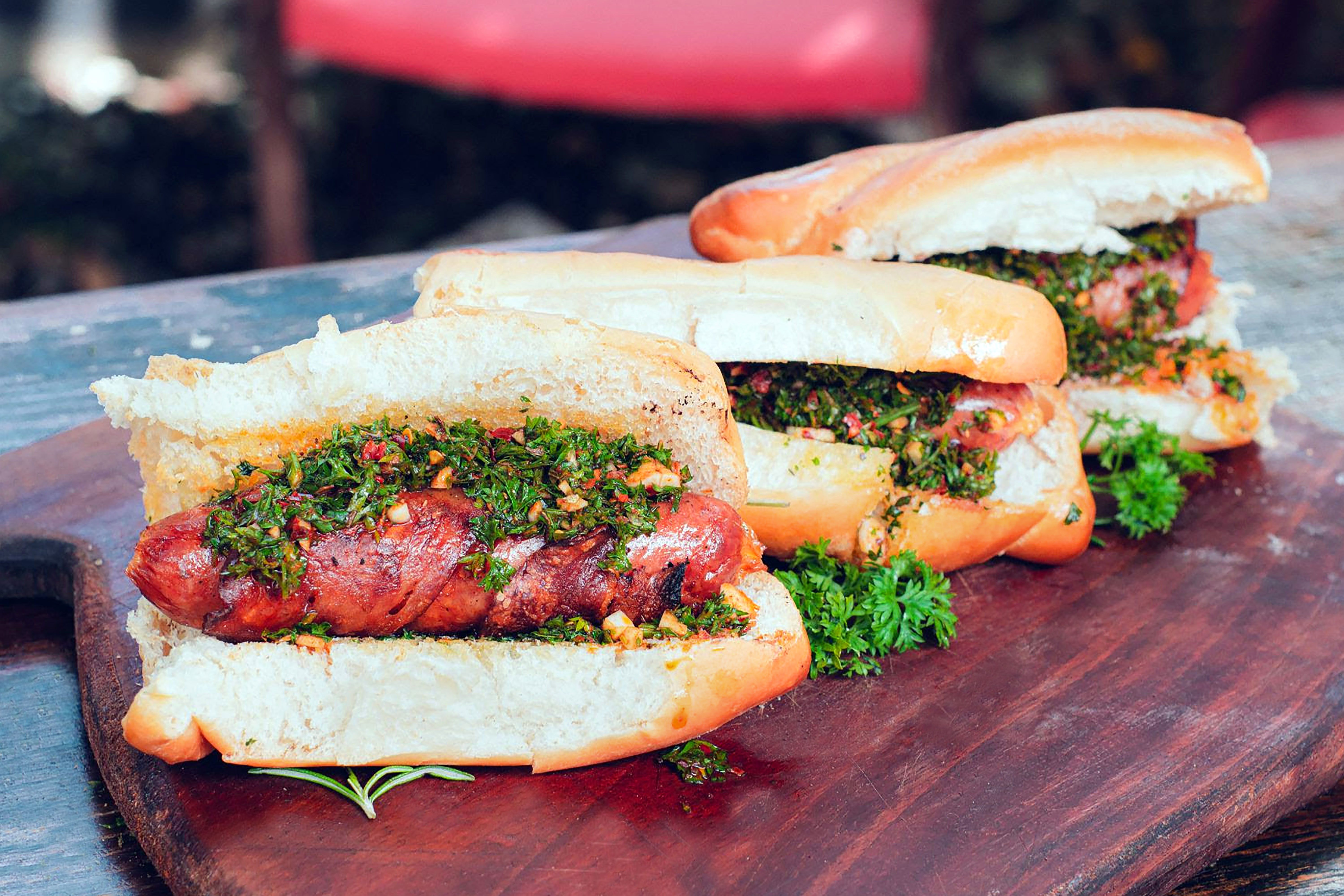What Is Argentine Food? It’s a vibrant tapestry of flavors, influenced by indigenous traditions, European immigration, and the country’s vast landscapes. FOODS.EDU.VN offers a delightful exploration into this rich culinary heritage, providing you with the knowledge and inspiration to savor the true taste of Argentina. Explore Argentinian cuisine, traditional dishes, and South American food culture here.
1. The Heart of Argentina: Asado (Barbecue)
Asado isn’t just a meal; it’s a social ritual, a celebration of meat, and a cornerstone of Argentine culture. Originating from the gauchos, the cowboys of the Pampas, asado traditionally involves grilling various cuts of meat over an open fire or parrilla (grill).
Expect a feast of beef, pork, ribs, sausages (chorizo and morcilla – blood sausage), and sweetbreads. In Patagonia, a whole lamb or pig roasted over an open flame is a spectacular sight. The meat is usually seasoned simply with salt, allowing the quality of the ingredients to shine. Chimichurri, a flavorful sauce, is often served alongside, and a glass of Malbec wine is the perfect accompaniment.
FOODS.EDU.VN provides detailed guides on mastering the art of asado, including selecting the right cuts of meat, building the perfect fire, and creating mouthwatering chimichurri.
Asado: A Breakdown
| Cut of Meat | Description |
|---|---|
| Bife de Chorizo | Sirloin steak, known for its marbling and flavor. |
| Lomo | Tenderloin, the most tender cut of beef. |
| Asado de Tira | Short ribs, cut across the bone. |
| Vacío | Flank steak, flavorful and best grilled over high heat. |
| Chorizo | Pork sausage, often seasoned with paprika and garlic. |
| Morcilla | Blood sausage, rich and savory. |
| Achuras | Offal, including sweetbreads (mollejas), kidneys (riñones), and chitterlings (chinchulines). |





2. Chimichurri: Argentina’s Signature Sauce
Chimichurri is the quintessential Argentine condiment, a vibrant green sauce made with finely chopped parsley, oregano, onion, garlic, chili pepper flakes, olive oil, and a touch of acid, typically vinegar or lemon juice. This versatile sauce is used as both a marinade and a table sauce, adding a burst of flavor to grilled meats, vegetables, and empanadas.
There are two main types of chimichurri:
- Chimichurri Verde (Green Chimichurri): The most common type, made with fresh herbs.
- Chimichurri Rojo (Red Chimichurri): Contains paprika and dried red peppers for a spicier, bolder flavor.
FOODS.EDU.VN features a range of chimichurri recipes, including variations with different herbs and spices, as well as tips for making the perfect chimichurri every time.
Chimichurri Variations
| Ingredient | Common Substitute | Reason for Substitution |
|---|---|---|
| Parsley | Cilantro | Offers a different, slightly citrusy flavor. |
| Oregano | Marjoram | Similar flavor profile, slightly sweeter. |
| Red Wine Vinegar | White Wine Vinegar, Lemon Juice | Provides a different level of acidity. |
| Chili Flakes | Fresh Chili Peppers (e.g., Jalapeño, Serrano) | Adds fresh heat and different flavor nuances. |
| Olive Oil | Avocado Oil | Lighter flavor profile and higher smoke point. |
3. Provoleta: Grilled Cheese, Argentine Style
Provoleta is a unique Argentine take on grilled cheese, showcasing the country’s Italian heritage. Thick slices of provolone cheese are seasoned with chili flakes and oregano, then grilled until the outside is crispy and caramelized, while the inside is gooey and melted. It’s often drizzled with olive oil or topped with chimichurri for an extra layer of flavor.
Provoleta is typically served as an appetizer at asados, providing a delicious and satisfying start to the meal.
FOODS.EDU.VN offers tips on selecting the best provolone cheese for grilling, as well as techniques for achieving the perfect crispy exterior and melted interior.
4. Dulce de Leche: Argentina’s Sweet Obsession
Dulce de leche, literally translated as “milk jam,” is a beloved Argentine confection made by slowly heating sweetened milk until it caramelizes into a thick, luscious spread. This sweet treat is used in countless desserts, from alfajores and dessert empanadas to ice cream (helado), pancakes, and toast.
The origins of dulce de leche are debated, with some claiming it originated in Argentina and others attributing it to neighboring countries like Uruguay. Regardless of its origin, dulce de leche is deeply ingrained in Argentine culinary culture.
FOODS.EDU.VN provides a step-by-step guide on making dulce de leche at home, as well as a collection of recipes featuring this irresistible ingredient.
Dulce de Leche Applications
| Application | Description |
|---|---|
| Alfajores | Sandwich cookies filled with dulce de leche. |
| Flan | Creamy custard dessert often topped with dulce de leche. |
| Ice Cream | Dulce de leche flavored ice cream or a swirl in vanilla ice cream. |
| Pancakes/Waffles | Used as a topping instead of syrup. |
| Toast | Spread on toast for a sweet breakfast or snack. |
| Cakes | Used as a filling between cake layers or as a frosting. |
5. Alfajores: Argentina’s Favorite Cookie
Alfajores are Argentina’s most popular cookie, consisting of two delicate, crumbly shortbread cookies sandwiched together with a generous filling of dulce de leche. They are often dusted with powdered sugar or coated in chocolate.
Alfajores have roots in Arab cuisine, brought to Spain by the Moors and later introduced to Argentina by Spanish colonists. Today, they are a ubiquitous treat found in bakeries, supermarkets, and kiosks throughout the country.
FOODS.EDU.VN offers a variety of alfajores recipes, including traditional versions and creative variations with different fillings and coatings.
6. Empanadas: Savory and Sweet Turnovers
Empanadas are a staple in Argentine cuisine, consisting of savory or sweet fillings encased in a pastry dough and baked or fried. They are another culinary gift from the Moors to Spain and eventually to Argentina. These portable and affordable meals are popular among all social classes.
Empanadas vary by region, with different fillings and cooking methods. Savory empanadas are typically filled with ground beef, chicken, cheese, vegetables, or a combination thereof. Sweet empanadas are often filled with quince jam, sweet potato paste (batata), or dulce de leche.
FOODS.EDU.VN features a comprehensive guide to making empanadas, including different dough recipes, filling ideas, and tips for achieving the perfect golden-brown crust.
Regional Empanada Variations
| Region | Typical Filling |
|---|---|
| Salta | Beef, potatoes, onions, hard-boiled eggs, and spices. |
| Tucumán | Beef, onions, bell peppers, and green olives. |
| Córdoba | Sweet empanadas filled with quince jam or sweet potato paste. |
| Patagonia | Lamb or seafood. |
| Buenos Aires | Ham and cheese, spinach and ricotta, or chicken. |
7. Matambre Arrollado: Rolled Meat “Hunger Killer”
Matambre arrollado is a unique Argentine dish featuring a thin cut of beef (matambre), typically flank steak, stuffed with vegetables, hard-boiled eggs, herbs, and olives. The meat is rolled tightly around the filling and then boiled, baked, or grilled.
The name “matambre” literally translates to “hunger killer,” as it was traditionally one of the first meats ready on the grill during an asado, helping to stave off hunger while waiting for the other cuts to cook.
FOODS.EDU.VN provides a detailed recipe for matambre arrollado, including tips for preparing the matambre, creating a flavorful filling, and achieving a perfectly cooked and rolled dish.
8. Yerba Mate: Argentina’s National Drink
Yerba mate is a traditional South American beverage made from the dried leaves of the yerba mate plant. It is a caffeinated drink that is rich in antioxidants and nutrients.
Yerba mate is typically consumed from a hollow gourd (mate) using a metal straw (bombilla) that filters the leaves. Sharing mate is a social ritual in Argentina, with the gourd being passed around a group, each person taking a turn to sip before passing it on.
FOODS.EDU.VN offers a guide to preparing and drinking yerba mate, including tips on selecting the right mate and bombilla, as well as information on the health benefits of this traditional beverage.
Yerba Mate Preparation Tips
| Step | Description |
|---|---|
| Filling the Mate | Fill the mate about ¾ full with yerba mate leaves. |
| Creating the Well | Tilt the mate to create a well on one side, leaving a space for the bombilla. |
| Adding Water | Pour lukewarm water into the well, allowing the leaves to absorb the water. |
| Inserting Bombilla | Insert the bombilla into the well, making sure it reaches the bottom. |
| Adding Hot Water | Slowly add hot (but not boiling) water to the well, being careful not to disturb the leaves too much. |
| Sharing | Enjoy the mate and pass it around to friends. The same leaves can be used for several rounds of water. |
9. Choripán: Argentina’s Ultimate Street Food
Choripán is a simple yet satisfying Argentine street food consisting of grilled chorizo sausage served on a crusty roll, typically topped with chimichurri sauce. It’s a popular snack at football matches, markets, and street stalls throughout the country.
The name “choripán” is a combination of “chorizo” (sausage) and “pan” (bread). It’s a quintessential Argentine comfort food that is both flavorful and affordable.
FOODS.EDU.VN provides a guide to making the perfect choripán, including tips on selecting the best chorizo, grilling it to perfection, and making a delicious chimichurri sauce.
10. Carbonada: A Hearty Winter Stew
Carbonada is a hearty and flavorful Argentine stew traditionally made with meat, potatoes, corn, carrots, peppers, and bacon, often with the addition of fruits like dried apricots, raisins, peaches, or pears. The stew is typically cooked in a hollowed-out pumpkin on the barbecue.
Carbonada is a popular dish during the cooler months, providing warmth and sustenance. Variations of carbonada can be found throughout the country, with different regions using different ingredients and cooking methods.
FOODS.EDU.VN offers a recipe for carbonada, including tips on selecting the best ingredients, preparing the pumpkin, and cooking the stew to perfection.
Ingredient Variations in Carbonada
| Ingredient | Regional Variation |
|---|---|
| Meat | Beef, lamb, chicken, or pork can be used. Some regions may use a combination of meats. |
| Vegetables | Potatoes (white and sweet), corn on the cob, carrots, onions, bell peppers, and tomatoes are common. Other vegetables like squash or zucchini may be added. |
| Fruits | Dried apricots, raisins, peaches, pears, and green grapes are often added for sweetness and flavor. Some regions may use other fruits like plums or apples. |
| Cooking Method | Traditionally cooked in a hollowed-out pumpkin on the barbecue. However, it can also be cooked in a pot on the stovetop or in the oven. |
| Seasoning | Paprika, cumin, oregano, and bay leaf are common seasonings. Some regions may add chili flakes for heat. |
| Liquid | Beef broth, vegetable broth, or water can be used as the liquid base. Some regions may add red wine for flavor. |
Beyond the Classics: Exploring Regional Argentine Cuisine
While the dishes listed above are staples throughout Argentina, each region boasts its own unique culinary specialties.
- The Northwest (Salta, Jujuy, Tucumán): Influenced by indigenous traditions, this region features dishes like humitas (corn and cheese tamales), locro (a hearty stew of corn, beans, and meat), and empanadas salteñas (small, savory pastries filled with beef, potatoes, and spices).
- The Northeast (Misiones, Corrientes, Entre Ríos): This region’s cuisine is influenced by its subtropical climate and neighboring countries like Paraguay and Brazil. Dishes include chipá (a cheesy bread made with cassava flour), surubí (a freshwater fish), and mbeyú (a cassava pancake).
- Patagonia (Neuquén, Río Negro, Chubut, Santa Cruz, Tierra del Fuego): Known for its vast landscapes and abundant seafood, Patagonia offers dishes like cordero patagónico (Patagonian lamb), centolla (king crab), and trucha (trout).
- Cuyo (Mendoza, San Juan, San Luis): This wine-producing region features dishes that complement its world-renowned wines, such as carne a la olla (pot roast), chivo a la cruz (goat roasted on a cross), and empanadas mendocinas (filled with beef, onions, and olives).
- The Pampas (Buenos Aires, Santa Fe, Córdoba, La Pampa): The heartland of Argentine agriculture, the Pampas is known for its beef and dairy products. Dishes include asado, milanesa (breaded beef cutlet), and pasta dishes influenced by Italian immigration.
FOODS.EDU.VN is dedicated to expanding its coverage of regional Argentine cuisine, providing you with authentic recipes and insights into the diverse culinary traditions of this fascinating country.
Argentine Cuisine: A Fusion of Cultures
Argentine cuisine is a testament to the country’s rich cultural heritage, blending indigenous traditions with European influences.
- Indigenous Influences: Native ingredients like corn, potatoes, beans, and squash are used in many traditional dishes, such as humitas, locro, and carbonada.
- Spanish Influences: Spanish colonists introduced ingredients like beef, wheat, olives, and wine to Argentina. Empanadas, dulce de leche, and alfajores are all derived from Spanish cuisine.
- Italian Influences: Waves of Italian immigrants in the late 19th and early 20th centuries had a profound impact on Argentine cuisine. Pasta dishes like ravioli and gnocchi are staples, as is pizza.
- Other European Influences: German, French, and British immigrants also contributed to Argentine culinary traditions, with dishes like strudel, croissants, and afternoon tea becoming popular.
FOODS.EDU.VN celebrates this fusion of cultures, showcasing the diverse flavors and techniques that make Argentine cuisine so unique and appealing.
The Future of Argentine Food: Innovation and Sustainability
While traditional dishes remain central to Argentine cuisine, there is a growing movement towards innovation and sustainability.
- Modern Argentine Cuisine: Chefs are experimenting with new techniques and ingredients, creating innovative dishes that showcase the country’s culinary heritage in a contemporary way.
- Sustainable Practices: There is increasing awareness of the importance of sustainable agriculture and food production. Farmers and chefs are working to promote environmentally friendly practices and support local producers.
- Plant-Based Cuisine: While Argentina is known for its meat-centric diet, there is a growing interest in plant-based cuisine. Restaurants are offering more vegetarian and vegan options, and chefs are exploring the potential of local fruits, vegetables, and grains.
FOODS.EDU.VN is committed to covering these developments, providing you with the latest news and insights on the future of Argentine food.
FAQ: Your Questions About Argentine Food Answered
- What is the most popular food in Argentina? Asado (barbecue) is widely considered the national dish of Argentina and is incredibly popular.
- What are some typical Argentine desserts? Dulce de leche, alfajores, and flan are among the most popular Argentine desserts.
- Is Argentine food spicy? Generally, Argentine food is not very spicy. Chimichurri sauce can add a bit of heat, but most dishes are seasoned with herbs and spices for flavor rather than heat.
- What is a typical Argentine breakfast? A typical Argentine breakfast is light, often consisting of toast with dulce de leche or jam, medialunas (croissants), and coffee or mate.
- What is the difference between Argentine chorizo and Spanish chorizo? Argentine chorizo is typically made with pork and beef and is not smoked, while Spanish chorizo is made with pork and is often smoked and seasoned with paprika.
- What is the best wine to pair with Argentine food? Malbec is the most popular wine in Argentina and pairs well with grilled meats, especially asado.
- What are some vegetarian options in Argentine cuisine? While Argentina is known for its meat, there are vegetarian options like empanadas filled with cheese and vegetables, pasta dishes, and salads.
- What is the history of dulce de leche? The origin of dulce de leche is debated, but it is believed to have originated in either Argentina or Uruguay in the 19th century.
- What is the proper way to drink mate? Mate is traditionally drunk from a gourd using a metal straw (bombilla). The gourd is passed around a group, with each person taking a turn to sip before passing it on.
- Where can I find authentic Argentine food outside of Argentina? Many major cities around the world have Argentine restaurants or food trucks. You can also find Argentine products like dulce de leche and yerba mate at specialty food stores or online.
Discover More at FOODS.EDU.VN
Are you eager to delve deeper into the captivating world of Argentine cuisine? FOODS.EDU.VN offers a wealth of resources, including:
- Detailed Recipes: Step-by-step instructions for preparing authentic Argentine dishes at home.
- Ingredient Guides: Learn about the unique ingredients used in Argentine cuisine and where to find them.
- Cultural Insights: Explore the history and traditions behind Argentine food.
- Restaurant Recommendations: Discover the best Argentine restaurants in your area.
Visit FOODS.EDU.VN today at 1946 Campus Dr, Hyde Park, NY 12538, United States or contact us on Whatsapp: +1 845-452-9600 to embark on your culinary adventure and unlock the secrets of Argentine cuisine. Let foods.edu.vn be your guide to experiencing the true taste of Argentina!